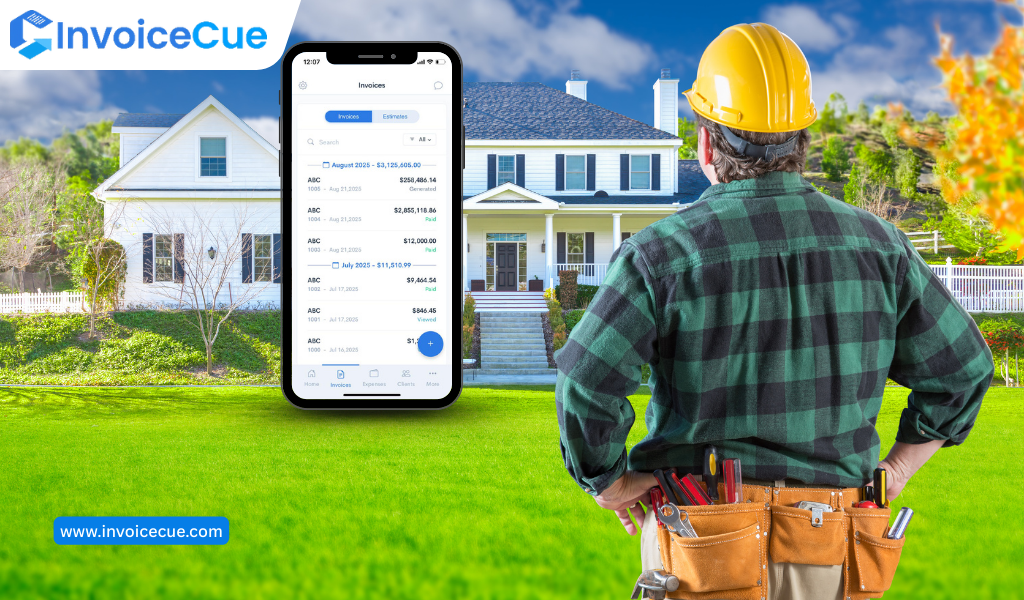Running a contracting business isn’t easy. From client visits, job site observation, and coordinating subcontractors, paperwork can soon stack up. The last thing you need to do is waste valuable time chasing payment or wrestling with paper receipts. That’s where an invoicing app for residential contractors can make a difference. By automating your billing process, you can accelerate payments, minimise errors, and get more organised on every job.
In this guide, we’ll walk through how modern invoice tools simplify billing, highlight essential invoicing app features, and explain why mobile solutions are becoming a game-changer for contractors across the US.
Why Residential Contractors Need Smarter Invoicing Solutions?
Residential projects often involve multiple phases, changes in scope, and partial payments. Traditional paper invoices or manual spreadsheets make it harder to keep track of deposits, change orders, and balances.
This is where residential contractor invoice software comes into play. With a digital solution, contractors are able to:
- Produce professional invoices in minutes.
- Easily track deposits and partial payments.
- Send automated reminders for past-due balances.
- Gain access to it all on the go with a mobile invoicing app.
In essence, technology not only makes things more efficient but also gets you paid faster without the disruption of jobsite paperwork.
The Power of a Mobile Invoicing App
Picture completing a project and having the capability to send a comprehensive invoice directly from your phone before exiting the worksite. A mobile invoicing app makes it a reality. You don’t have to wait until you return to the office to do billing.
The following are the key advantages:
- On-the-fly invoicing—invoice customers as soon as a job is completed.
- Immediate payment methods—most apps have payment gateways such as credit cards or ACH transfers.
- Reduction of errors—automated computations minimize errors prevalent with manual invoices.
Through providing quick, easy billing, contractors establish trust with customers and shorten the cycle of payment.
Key Invoicing App Features Residential Contractors Need to Find
All invoicing apps are not made alike. When considering invoice software as a residential contractor, find ones that address the distinct needs of your business. Here are some that are must-haves:
- Personalized Invoice Templates—Personalize invoices with your logo, job information, and payment terms.
- Partial Payment & Deposit Monitoring – Ideal for phase payment projects, keeping precise records of what has been paid and outstanding.
- Automatic Reminders—Lower overdue payments with courteous, automatic reminders.
- Mobile Accessibility—Ideal for busy contractors who spend a lot of time on-site.
- Cloud Storage & Syncing—Secure your invoices, keep them organized, and access them from any device.
When all these invoicing app functionalities are combined, contractors are able to simplify their workflow and prevent expensive delays.
How Partial Payment & Deposit Tracking Makes Billing Easier?
Large house jobs typically demand deposits or milestone payments. Keeping track of these manually is a nuisance.
- Partial payment & deposit tracking lets you:
- Track upfront deposits and show them on final invoices.
- Handle multiple installments without confusion.
- Offer clients clear statements with payment history.
This not only makes your cash flow strong but also earns the trust of homeowners who appreciate transparency.
From Paperwork to Profits: Business Benefits
Make the change to residential contractor invoice software more than an administrative improvement—it has a direct impact on your bottom line. Contractors who adopt digital invoicing experience:
- Quicker payments—Most clients pay faster when they get digital invoices with online payment methods.
- Less administrative time—Contractors have less time on paperwork and more time on the projects.
- Increased visibility of cash flow—Real-time reporting provides an easier way to view where your money is coming from.
- Professionalism—Professional, clean invoices boost customer confidence.
When your billing process is working well, your business is working well too.
The Reasons Behind the Use of Digital Invoice Tools by US Contractors
There is fierce competition in the US home improvement and construction market. Contractors who operate their businesses efficiently and provide exceptional service are distinguished. Today’s clients anticipate flawless digital experiences, from online bill payment to consultation scheduling.
Because of this, residential contractors are increasingly using invoice tools as a requirement rather than an option. You run the risk of losing business to rivals who accept payments more quickly and easily if you continue to use paper invoices.
Conclusion
Outdated invoicing techniques slow you down and negatively impact your cash flow in the fast-paced business world of today. You can reduce the amount of paperwork on the job site, easily track partial payments, and get paid more quickly by using an Invoicing App for Residential Contractors. You’ll also look more professional.
The time to invest in digital invoicing is now if you’re prepared to simplify your billing and concentrate more on building homes than on collecting payments.
FAQs on Invoicing App for Residential Contractors
1. What is the best way for residential contractors to create invoices?
Features like online payment integrations, automated reminders, partial payment tracking, and mobile access are all included in the best residential contractor invoice software.
2. If I don’t have an office, can I still use a mobile invoicing app?
Of course. For contractors who are constantly on the go, there is a mobile invoicing app. Invoices can be created, sent, and managed right from your tablet or phone.
3. How can contractors benefit from tracking deposits and partial payments?
By clearly documenting deposits and installments, it streamlines billing for multi-phase projects and keeps clients and contractors informed about outstanding balances.
